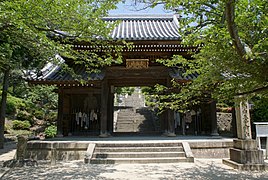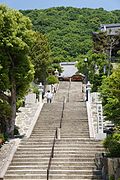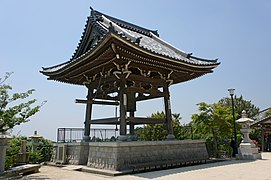Kannō-ji
The Kannō-ji ( Japanese 神 呪 寺 ) is a temple of the Omuro branch ( 御 室 派 ) of the Shingon direction of Buddhism in Nishinomiya ( Hyōgo Prefecture ). It lies on the slope of the 309 m high Kabutoyama and is therefore usually called Kabutoyama Daishi ( 甲 山 大師 ). It is the 21st temple on the New Saigoku Pilgrimage Route .
history
A daughter of Emperor Junna , Princess Mai Gozen ( 真 井 御前 ; 803-833) turned to Buddhism and left the imperial family. At the age of 29, she had a place of prayer set up on Mount Kabutayana, called herself “Nyoini” ( 如意 尼 ) on the instructions of priest Kūkai and shaved her head as a nun. That was the beginning of Kannō-ji.
investment
You enter the facility at the foot of the hill through the temple gate ( 山門 Sanmon ), which is designed here as a Niō gate ( 仁王 門 ; in plan 1), i.e. as a gate with the two temple guards to the right and left of the passage. After crossing a street, the path continues up stairs to the inner temple area, which is surrounded by a wall and extends at the height. Immediately to the right is the bell tower ( 鐘楼 Shōrō ; 2). The main hall stands in front ( 本 堂 Hondō ; 3).
To the right of the main hall of the close Fudō-Hall (and 不動堂 ; 4) and the Urnenhalle ( 納骨堂 Nōkotsudō ; 5) to, on the left side which follows Daishidō ( 大師堂 ; 6) and the Abbot and Monk area (A). On the right, in the upper rear part of the site, is the small treasure pagoda ( 多 宝塔 Tahoto ; 7).
Temple treasures
The following are registered as important cultural assets of Japan :
- Sitting Nyoirin-Kannon ( 木造 如意輪 観 音 坐像 Mokuzō Nyoirin Kannon zazō ). However, it does not come from Kūkai, as the temple tradition says, but was only made in the 10th or 11th century.
- Standing Kannon ( 木造 聖 観 音 立 像 Mokuzō Shō-Kannon ritsuzō ) from the Heian period .
- Seated Fudō Myōō ( 木造 不 動 明王 坐像 Mokuzō Fudō Mōō zazō ) from the Kamakura period .
- Seated Kōbō Daishi (Kūkai) ( 木造 弘法 大師 坐像 Mokuzō Kōbō Daishi zazō ) from the Kamakura period.
photos
literature
- Hyōgo-ken no rekishi sampo henshu iinkai (ed.): Kannō-ji . In: Hyogo-ken no rekishi sampo (jo). Yamakawa Shuppan, 2012. ISBN 978-4-634-24628-7 . P. 155.
Web links
Coordinates: 34 ° 46 ′ 23.3 " N , 135 ° 19 ′ 47.2" E







